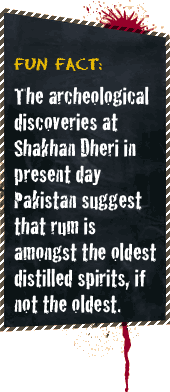Lesson Three: How People Make Distilled Spirits
Chapter Three: Too Much Flavor, Man
With all due respect to history’s forgotten distillers, it’s a pretty absurd leap of faith to imagine that smoothness or mildness was foremost in their minds. We’re thinking, maybe, I dunno, money? Getting drunk? Not getting blown up if the still breaks? Things like that.
And in fact, there were other ways to make something delicious; focusing upon quality of distillation could fairly be described as a more modern pursuit. Alternate options included the addition of flavors (sugar, spices, fruits, lotsa stuff out there) and in the 18th and 19th centuries, people began to believe in the virtue of barrel aging, again, to smooth out the rather harsh base spirit.
Making the Medicine Go Down
Think about some of the older brands: Kummell (a caraway flavored white spirit established in 1622); gin (various version are seen in the early 1600s), spiced rum (some barrels in the 17th century were branded). All these old spirit categories are based upon flavoring; indeed, it’s not unflattering to say that the added elements were sometimes only of secondary importance. Sure, juniper berries were seen as potentially protecting people from plague; some of the other classic botanicals aren’t even particularly noticeable, though such additions can help smooth the palate nonetheless.
And if quality wasn’t uppermost in mind, many of these distillates need to be viewed not as popular beverages but as popular medicines, stimulants, digestifs…medicine. Deliciousness is an unexpected pleasure, if it should happen.
The alcohol level of a spirit is sometimes constrained by regulation: in the U.S. vodka or gin is supposed to be at least 80 proof*, unless it’s a flavored vodka. The EU demands a minimum of 75 proof only. In fact, gin was traditionally 90 proof or higher; British authorities wanted to curtail public drunkenness and in 1976 demanded that London Dry Gin be reduced further to 86 proof. Some gin drinkers lamented such an abrupt shift from the standard set over centuries, and in the U.S., some brands have continued at their loftier levels. So labels such as Tanqueray have continued being sold at 94 proof in the U.S., while the UK has to be satisfied with a much milder 86 proof. Maybe it doesn’t seem like a huge difference but the aromatic expression is altered. Perhaps more significantly, the rich texture of traditional Tanqueray is lightened; one of my favorite martinis is less silky in the UK than it used to be.
One crucial notion to swallow: the level at which a spirit is distilled impacts its intensity. If a spirit is distilled to a very high level, say, the 192 proof minimum required for vodka, the spirit pouring forth from the still will be relatively neutral. Why? Because in order to get to something that is nearly pure alcohol (like 192 proof), repeated distillations are required, and each distillation will remove some flavors.
Of course, when people hear that vodka is distilled to 192 proof they focus upon the implied power of 192 proof. But vodka is generally consumed at 80 proof, so distilled (or otherwise neutralized) water is added to bring the proof down. And if there is a single descriptor applied to vodka it is that excellent vodka is smooth and mild.
When we think about some of the world’s most intense and flavorful spirits, Tequila comes to mind. Most Tequilas are bottled at 80 proof, the same as vodka, so why are they so much more powerful? Well, it is that many Tequilas are distilled to only about 110 or 120 proof, and that provides the distiller far fewer chances to make a gentle, mild beverage.
So now as we go through each of the spirit categories, we are going to have to think about the level at which that spirit is usually distilled, because it will provide a clue as to how flavorful and intense or gentle and mild that spirit is likely to be.
Ready for Review?
Now you can click on the “Lesson Four – White Spirits” button below to continue your lessons on how alcohol beverages are made.


